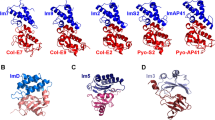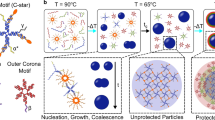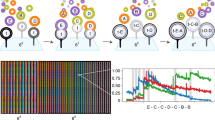Abstract
Numerous biological processes involve the recognition of a specific pattern of binding sites on a target protein or surface. Although ligands displayed by disordered scaffolds form stochastic rather than specific patterns, theoretical models predict that recognition will occur between patterns that are characterized by similar or “matched” statistics1,2,3,4. Endowing synthetic biomimetic structures with statistical pattern matching capabilities may improve the specificity of sensors and resolution of separation processes5. We demonstrate that statistical pattern matching enhances the potency of polyvalent therapeutics. We functionalized liposomes with an inhibitory peptide at different densities and observed a transition in potency at an interpeptide separation that matches the distance between ligand-binding sites on the heptameric component of anthrax toxin. Pattern-matched polyvalent liposomes inhibited anthrax toxin in vitro at concentrations four orders of magnitude lower than the corresponding monovalent peptide, and neutralized this toxin in vivo. Statistical pattern matching also enhanced the potency of polyvalent inhibitors of cholera toxin. This facile strategy should be broadly applicable to the detection and neutralization of toxins and pathogens.
This is a preview of subscription content, access via your institution
Access options
Subscribe to this journal
Receive 12 print issues and online access
$209.00 per year
only $17.42 per issue
Buy this article
- Purchase on Springer Link
- Instant access to full article PDF
Prices may be subject to local taxes which are calculated during checkout



Similar content being viewed by others
References
Srebnik, S., Shakhnovich, E.I. & Chakraborty, A.K. Adsorption/freezing transition for random heteropolymers near disordered 2-D manifolds due to pattern matching. Phys. Rev. Lett. 77, 3157 (1996).
Johnson, R.D., Wang, Z.-G. & Arnold, F.H. Surface site heterogeneity and lateral interactions in multipoint protein adsorption. J. Phys. Chem. 100, 5134–5139 (1996).
Golumbfskie, A.J., Pande, V.S. & Chakraborty, A.K. Simulation of biomimetic recognition between polymers and surfaces. Proc. Natl. Acad. Sci. USA 96, 11707–11712 (1999).
Jayaraman, A., Hall, C.K. & Genzer, J. Designing pattern-recognition surfaces for selective adsorption of copolymer sequences using lattice monte carlo simulation. Phys. Rev. Lett. 94, 078103 (2005).
Mallik, S. et al. Towards materials for the specific recognition and separation of proteins. N. J. Chem. 18, 299–304 (1994).
Collier, R.J. & Young, J.A. Anthrax toxin. Annu. Rev. Cell Dev. Biol. 19, 45–70 (2003).
Rainey, G.J. & Young, J.A. Antitoxins: Novel strategies to target agents of bioterrorism. Nat. Rev. Microbiol. 2, 721–726 (2004).
Maynard, J.A. et al. Protection against anthrax toxin by recombinant antibody fragments correlates with antigen affinity. Nat. Biotechnol. 20, 597–601 (2002).
Mourez, M. et al. Designing a polyvalent inhibitor of anthrax toxin. Nat. Biotechnol. 19, 958–961 (2001).
Abrami, L., Lindsay, M., Parton, R.G., Leppla, S.H. & van der Goot, F.G. Membrane insertion of anthrax protective antigen and cytoplasmic delivery of lethal factor occur at different stages of the endocytic pathway. J. Cell Biol. 166, 645–651 (2004).
Torchilin, V.P. Recent advances with liposomes as pharmaceutical carriers. Nat. Rev. Drug Discov. 4, 145–160 (2005).
Kingery-Wood, J.E., Williams, K.W., Sigal, G.B. & Whitesides, G.M. The agglutination of erythrocytes by influenza virus is strongly inhibited by liposomes incorporating an analog of sialyl gangliosides. J. Am. Chem. Soc. 114, 7303–7305 (1992).
Spevak, W. et al. Polymerized liposomes containing C-glycosides of sialic acid: potent inhibitors of influenza virus in vitro infectivity. J. Am. Chem. Soc. 115, 1146–1147 (1993).
Ladokhin, A.S., Jayasinghe, S. & White, S.H. How to measure and analyze tryptophan fluorescence in membranes properly and why bother? Anal. Biochem. 285, 235–245 (2000).
Sackmann, E. Supported membranes: scientific and practical applications. Science 271, 43–48 (1996).
Israelachvili, J . Intermolecular & Surface Forces (Academic Press, London, 1992).
Tocanne, J.-F., Dupou-Cezanne, L. & Lopez, A. Lateral diffusion of lipids in model and natural membranes. Prog. Lipid Res. 33, 203–237 (1994).
Chan, P.-Y. et al. Influence of receptor lateral mobility on adhesion strengthening between membranes containing LFA-3 and CD2. J. Cell Biol. 115, 245–255 (1991).
Gujraty, K. et al. Functional characterization of peptide-based anthrax toxin inhibitors. Mol. Pharm. 2, 367–372 (2005).
Fan, E., Merritt, E.A., Verlinde, C.L. & Hol, W.G. AB5 toxins: structure and inhibitor design. Curr. Opin. Struct. Biol. 10, 680–686 (2000).
Holmgren, J., Lonnroth, I., Mansson, J.-E. & Svennerholm, L. Interaction of cholera toxin and membrane GM1 ganglioside of small intestine. Proc. Natl. Acad. Sci. USA 72, 2520–2524 (1975).
Merritt, E.A. et al. Crystal structure of cholera toxin B-pentamer bound to receptor GM1 pentasaccharide. Protein Sci. 3, 166–175 (1994).
Svennerholm, A.M. & Holmgren, J. Identification of Eschericia coli heat-labile enterotoxin by means of a ganglioside immunosorbent assay (GM1-ELISA) procedure. Curr. Microbiol. 1, 19–23 (1978).
Tristram-Nagle, S., Petrache, H.I. & Nagle, J.F. Structure and interactions of fully hydrated dioleoylphosphatidylcholine bilayers. Biophys. J. 75, 917–925 (1998).
Sun, W.-J., Tristram-Nagle, S., Suter, R.M. & Nagle, J.F. Structure of gel phase saturated lecithin bilayers: temperature and chain length dependence. Biophys. J. 71, 885–891 (1996).
Soumpasis, D.M. Theoretical analysis of fluorescence photobleaching recovery experiments. Biophys. J. 41, 95–97 (1983).
Minke, W.E., Roach, C., Hol, W.G. & Verlinde, C.L. Structure-based exploration of the ganglioside GM1 binding sites of Escherichia coli heat-labile enterotoxin and cholera toxin for the discovery of receptor antagonists. Biochemistry 38, 5684–5692 (1999).
Cunningham, K., Lacy, D.B., Mogridge, J. & Collier, R.J. Mapping the lethal factor and edema factor binding sites on oligomeric anthrax protective antigen. Proc. Natl. Acad. Sci. USA 99, 7049–7053 (2002).
Guex, N. & Peitsch, M.C. SWISS-MODEL and the Swiss-PdbViewer: an environment for comparative protein modeling. Electrophoresis 18, 2714–2723 (1997).
Humphrey, W., Dalke, A. & Schulten, K. VMD—Visual Molecular Dynamics. J. Mol. Graph. 14, 33–38 (1996).
Acknowledgements
This work was supported by National Institutes of Health grant UO1 AI056546. J.M. holds the Canada Research Chair in Bacterial Pathogenesis.
Author information
Authors and Affiliations
Corresponding authors
Ethics declarations
Competing interests
The authors declare no competing financial interests.
Supplementary information
Supplementary Fig. 1
Preincubation of peptide-functionalized liposomes with [PA63]7 decreases the measured IC50. (PDF 64 kb)
Supplementary Fig. 2
Influence of ligand density and preincubation time on the inhibitory potency of DSPC-based galactose-functionalized liposomes (PDF 68 kb)
Supplementary Table 1
Estimated average inter-ligand separations for DSPC-based and DOPC-based liposomes as a function of ligand density (PDF 39 kb)
Rights and permissions
About this article
Cite this article
Rai, P., Padala, C., Poon, V. et al. Statistical pattern matching facilitates the design of polyvalent inhibitors of anthrax and cholera toxins. Nat Biotechnol 24, 582–586 (2006). https://doi.org/10.1038/nbt1204
Received:
Accepted:
Published:
Issue Date:
DOI: https://doi.org/10.1038/nbt1204
This article is cited by
-
Designer DNA architecture offers precise and multivalent spatial pattern-recognition for viral sensing and inhibition
Nature Chemistry (2020)
-
Validation of a Janus role of methotrexate-based PEGylated chitosan nanoparticles in vitro
Nanoscale Research Letters (2014)
-
Bacteria clustering by polymers induces the expression of quorum-sensing-controlled phenotypes
Nature Chemistry (2013)
-
The targeted delivery of multicomponent cargos to cancer cells by nanoporous particle-supported lipid bilayers
Nature Materials (2011)
-
Nanotube-assisted protein deactivation
Nature Nanotechnology (2008)



